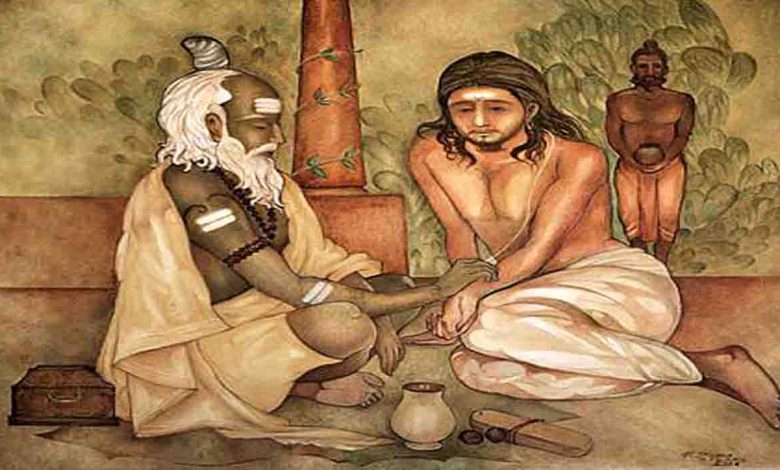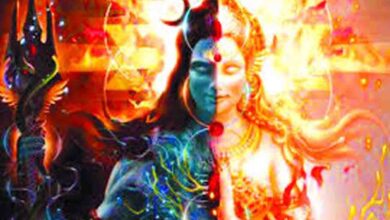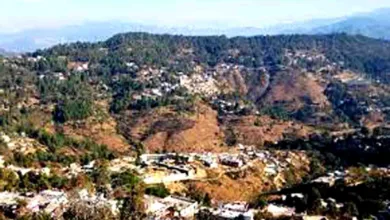Health and disease in ancient India

Monday, 07 June 2021 | Roshen Dalal | in Guest Column
GUEST COLUMN
 Roshen Dalal
Roshen Dalal
As the world reels under the Covid pandemic, we find that the history of diseases dates back to the earliest times, indicated even by the early legend of Dhanvantari, an incarnation of the god Vishnu, who emerged from the kshir-sagara, the ocean of milk, carrying the vessel of amrita, the divine drink of immortality. Dhanvantari is said to be the physician of the gods, and the first of all physicians on earth. This legend is post-Vedic, but diseases and their remedies can be traced back to the Vedas and even earlier.
Even in the Paleolithic Age, people suffered both from diseases and from injuries; attempts must have been made to cure them, to help them heal. We don’t know what these early attempts were but by the Bronze Age, medicine and systems of healing including surgery, the use of herbs and spiritual methods were used in ancient Egypt, Iran, India, Mesopotamia and other parts of the ancient world.
In India-Pakistan, in the Harappan civilisation (2600-1900 BCE), some Harappan seals and artefacts have been interpreted from the standpoint of medicine. Kenneth G Zysk, an Indologist from the University of Copenhagen, also suggested that the extensive drainage system in Harappan cities indicated ‘a concern for public health and sanitation’, and that perhaps the Great Bath at Mohenjodaro was used for hydrotherapy, though the latter seems unlikely. On the other hand, David Clark, in his book Germs, Genes, and Civilization, links the Harappan drainage system with the spread of water-borne diseases causing the downfall of the civilisation.
The Rig Veda and later Vedic Samhitas, particularly the Atharva Veda, have references to the healing and curing of ailments. The Rig Veda can be dated to 1500 BCE or earlier, while the Atharva Veda probably dates to around 1000 BCE. Bheshaja is the term used for medicine or a remedial measure in the Vedic texts; remedies included plants, water, and spells. A bhishaj or physician is frequently mentioned, right from the time of the Rig Veda. Among the Vedic gods, the Ashvins, Varuna, and Rudra are known as bhishaj. One hymn in the Rig Veda (10.97) refers to a physician with his plants and healing powers. In the same text, the Ashvins, the twin horsemen, are the greatest healers, who could heal the lame and the blind, restore youth, and even replace a leg with a metal one. These miraculous cures may have been mythical or based on ancient stories and legends. They do not exist in the Atharva Veda, which describes different methods to treat illness and disease. However, the practice of medicine seems to have been a profession by the time of the Rig Veda.
The Vedic texts also reflect a knowledge of the body and its functions, and some knowledge of human anatomy. The Atharva Veda provides information on the body, mentions diseases and also indicates the plants and herbs used to cure these. Herbs that can cure disease are also praised in prayers and invocations. There are prayers to water, which has healing powers, and to fire, which is believed to guard against demons. Both pishachas and rakshasas, types of demons, were believed to cause diseases. Healing rituals, accompanied by chants, are described. Diseases, personified as demons, were sent to far off countries or peoples, carried away by birds, or transferred to the ground.
But apart from these, many diseases are actually described in the Vedic Samhitas, particularly in the Atharva Veda, and a few of these are listed here.
Yakshma is a general term indicating ‘disease’. In later texts, yakshma is a term for consumption but in the Vedic Samhitas it is not used in such a specific way. Yakshma occurred in both human adults and children, and in cattle, causing pain, fever and debility.
Jayenya or jayanya is mentioned with jaundice and pain in limbs. If these are its symptoms, it could be some kind of liver disease. It has also been mentioned with yakshma and with apachit (‘skin sores’). Like yakshma, it pervaded the whole body. It also led to a swollen belly.
Takman, or fever, has several hymns related to it in the Atharva Veda. The term takman for fever is used only in this text. Takman had several different varieties. Some of the fevers described are clearly malarial, while others are associated with rashes. Two verses from an Atharva Veda hymn are below:
‘When you, being cold, and then again deliriously hot, accompanied by cough, did cause the (sufferer) to shake, then O takman, your missiles were terrible: from these surely exempt us!
Destroy the takman that returns on (each) third day, the one that intermits (each) third day, the one that continues without intermission, and the autumnal one; destroy the cold takman, the hot, him that comes in summer, and him that arrives in the rainy season!’ (Atharva Veda 5.22. 10,13.)
Some ailments associated with takman in the Atharva Veda are kasha (cough); paman, a skin disease, which could be an itch, eruptions or scabs that occur with fever; prishtyamaya, a pain in the sides or ribs; and asharika, possibly the pain in limbs that accompanies fever.
Balasa is mentioned several times in the Atharva and occasionally later. The medieval commentators Mahidhara and Sayana interpreted it as consumption; it is said to be a kind of yakshma, because of which bones and joints fall apart. It causes lumps in the armpits, suggesting a disease associated with the lymph glands.
Hariman mentioned in the Rig Veda, Atharva Veda, and elsewhere indicates yellowness in a disease, and that is clearly jaundice.
Hridroga or heart disease is mentioned in the Rig Veda. It seems to be the same as the hridayamaya and hridyota cited in the Atharva.
Kshetriya seems to be an internal disease with multiple symptoms. It is associated with yakshma, and with seizure (grahi) and evil spirits.
Rapas is mentioned in the Rig and the Atharva, and seems to be a term for a disease, though it has also been translated as ‘wound’. The disease attacked the foot and joints, particularly knees and ankles. A crawling creature known as ajakava was said to live under the skin and cause this. Alternatively, it was caused by polluted water or by a creature living in water.
This is just a sample of some of the diseases mentioned. In addition various terms and descriptions have been analysed to indicate references to eye diseases, malnutrition, anaemia, various swellings and skin disorders, diseases caused by worms, hair loss, stomach problems, paralysis, haemorrhoids, tetanus, convulsions, rheumatism, muscular dystrophy and leprosy, among others.
Mental diseases too were known. Insanity of two types is referred to: unmadita, probably that which was self-created or circumstantial, and unmatta, ‘demonic possession’.
Remedies included spells, chants and the use of various herbs, some of which are still used in Ayurveda today.
The Atharva Veda thus provided the basis for the medical science of Ayurveda, later systematised in Ayurvedic texts that probably date to the first few centuries CE or somewhat earlier, and include the works of Bhela, Charaka, and Sushruta. Medicine was also extensively studied in Buddhism and taught in monasteries. Bhaishajya guru is the Buddha of healing.
Later epidemics such as plague, cholera, or influenza that spread across the world are well documented, along with the ravages caused by germs during the invasions of the Americas and Australia-New Zealand, but these early texts show that the battle against disease started very long ago.
(A PhD in ancient Indian History, the writer lives in Dehradun and has authored more than ten books)






